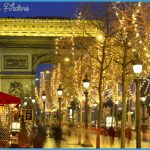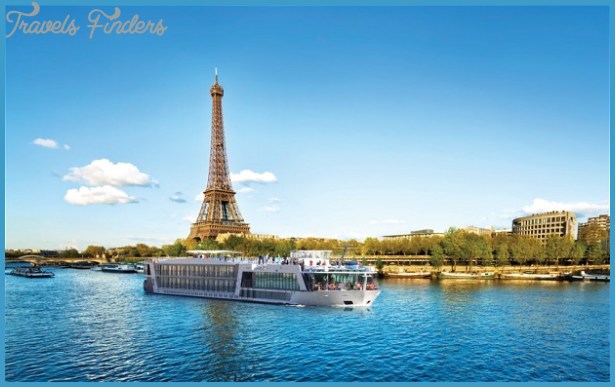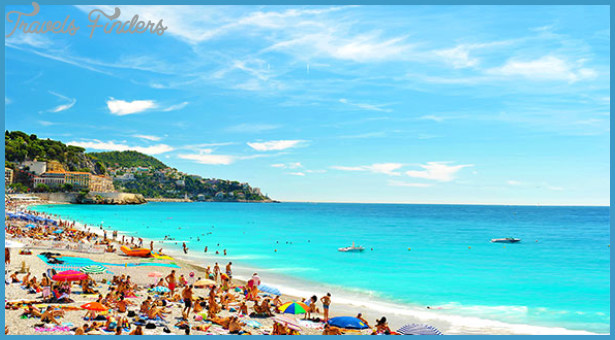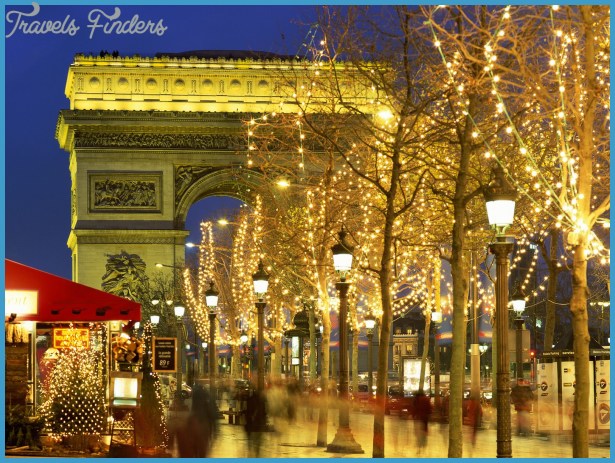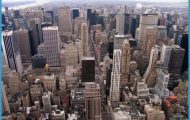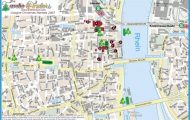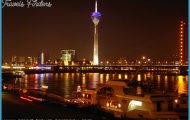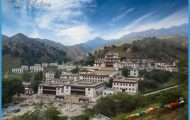Holiday in France
OPERA BASTILLE. Lake its namesake, the Opera Bastille has stirred up a lot of opposition. One of Mitterrand’s Grands Projets, the Opera, designed by a Canadian, opened in 1989 to protests over its unattractive design. On the tour (expensive but extremely impressive) you’ll see a different side of the largest theater in the world. The immense auditorium seats 2703 people, but 95% of the building is taken up by exact replicas of the stage for rehearsals and workshops. (M: Bastille. 130 r. de Lyon. nOl 40 01 19 70; www.opera-de-pahs.fr. 10, over-60 8, students and under-26 5. lhr. tour almost every day, usually at 1 or 5pm; call ahead (tours in French, but groups of ten or more can arrange for English.)
PLACE DE LA CONCORDE. Paris’s most famous public square lies at the eastern end of the Champs-Elysees. Built between 1757 and 1777 as a monument to Louis X, the area soon became the place de la Revolution, site of the guillotine that severed 1343 necks from their blue-blooded bodies. After the Reign of Terror, the square was renamed concorde (peace). The huge, rose-granite, 13th-century BC Obelisque de Luxor depicts the deeds of Egyptian pharaoh Ramses II. Given to Charles X by the Viceroy of Egypt, it is Paris’s oldest monument. (M: Concorde.)
CHAMPS-ELYSEES. Stretching west and anchored by the Arc de Triomphe on one end and the pi. de Concorde on the other, the legendary avenue des Champs-Elysees is lined with luxury shops, chain stores, cafes, and cinemas. The avenue is the work of Baron Haussmann, who was commissioned by Napoleon III to convert Paris into a grand capital with broad avenues, wide sidewalks, new parks, elegant housing, and sanitary sewers. The city’s most elegant shopping is on avenue Mon-tagne and rue Faubourg St-Honore.
ARC DE TRIOMPHE. Napoleon commissioned the Arc de Triomphe, at the western terminus of the Champs-Elysees, in 1806 in honor of his Grande Armee. In 1940, Parisians were brought to tears as Nazis goose-stepped through the Arc; on August 26,1944, British, American, and French troops liberating the city from Nazi occupation marched through to the roaring cheers of thousands. The terrace at the top has a fabulous view. The Tomb of the Unknown Soldier has been under the Arc since November 11, 1920. It bears the inscription, “Here lies a French soldier who died for his country, 1914-1918,” but represents the 1,500,000 men who died during WWI. (On pi. Charles de Gaulle. M: Charles-de-Gaulie-Etoile. Open Apr.-Sept. daily 10am-11pm; Oct.-Mar. 10am-10;30pm. 7, ages 18-25 4.50. Under-17 free.)
THE MADELEINE. Mirrored by the Assemblee Nationale across the Seine, the Madeleine formally called Eglise Ste-Marie-Madeleine (Mary Magdalene) was begun in 1764 by Louis XV and modeled after a Greek temple. Construction was halted during the Revolution, when the Cult of Reason proposed transforming the building into a bank, a theater, or a courthouse. Characteristically, Napoleon decreed that it should become a temple to the greatness of his army, but Louis
XVIII shouted, “It shall be a church!” Completed in 1842, the structure stands alone in the medley of Parisian churches,, distinguished by four ceiling domes that light the interior, 52 exterior Corinthian columns, and a curious altarpiece. (PI. de la Madeleine. M: Madeleine. 01 44 51 69 00. Open daily 7:30am-7pm.)
PLACE DU TROCADERO. In the 1820s, the Due d’Angouleme built a memorial to his victory in Spain at Troeadero. Jacques Carlu’s modem design for the 1937 World Exposition (which beat out Le Corbusier’s plan) for the Palais de Chaillot features two white stone wings cradling an austere, Art Deco courtyard that extends from the place over spectacular cannon-shaped fountains. The terrace offers brilliant views of the Eiffel Tower and Champs de Mars, particularly at night Be aware of possible pickpockets as you gaze upward. (M: Troeadero.)
MOUNTING MONTMARTRE. Montmartre, comprised mostly of one very large hill, is one of the few Parisian neighborhoods Baron Haussmann left intact when he redesigned the city and its environs. During its Belle Epoque heyday from 1875 to 1905, it attracted bohemians like Toulouse-Lautrec and Erik Satie as well as performers and impresarios like Aristide Bruant. Later, Picasso, Modigliani, Utrillo, and Apollinaire came into its artistic circle. Nowadays, Montmartre is a mix of upscale bohemia (above r. des Abbesses) and sleaze (along bd. de Clichy). The northwestern part of the area retains some village charm, with breezy streets speckled with interesting shops and cafes. (Funicular runs cars up and down the hill every 2min. Open 6am-12:30am. 1.30 or Metro ticket. M: Anvers or Abbesses.)
BASILIQUE DU SACRE-COEUR. The Basilique du Sacre-Coeur crowns the butte Montmartre like an enormous white meringue. Its onion dome is visible from almost anywhere in the city, and its 112m bell tower is the highest point in Paris, offering a view that stretches up to 50km. (35 r. du Chevalier de la Barre. M: Anvers, Abbesses, or Chateau-Rouge. 01 53 41 89 00. Open daily 7am-10:30pm. Wheelchair accessible through back. Free. Dome and crypt open daily 9am-6:45pm. 5.) Nearby, place du Tertre is full of touristy cafes and amateur artists.
BAL DU MOULIN ROUGE. Along the bd. de Clichy and bd. de Rochechouart, you’ll find many of the cabarets and nightclubs that were the definitive hangouts of the Belle Epoque, including the infamous cabaret Bal du Moulin Rouge, immortalized by the paintings of Toulouse-Lautrec, the music of Offenbach, and, most recently, Baz Luhrmann’s Hollywood blockbuster. (M: Blanche. 82 bd. de Clichy. Directly across from the m&tm. vOl 53 09 82 82; www.moulin-rouge.com. Shows 7, 9,11pm.)
PARC DES BUTTES-CHAUMONT. In the south of the 19eme, Parc des Buttes-Chaumont is a mix of man-made topography and transplanted vegetation; Napoleon IH commissioned it in 1860 out of a longing for London’s Hyde Park, where he spent much of his exile. Today’s visitors walk the paths surrounded by lush greenery and dynamic hills, and enjoy a great view of the quartier from the cave-filled cliffs topped with a Roman temple. Watch out for the ominously-named Pont des Suicides. (M: Buttes-Chaumont and Botzaris both exit onto the park. Open daily 7am-llpm.)
CIMETIERE PERE LACHAISE. The Cimetiere Pere Lachaise, located in the 20eme, holds the remains of Balzac, Sarah Bernhardt, Colette, Danton, David, Delacroix, La Fontaine, Haussmann, Moliere, Proust, and Seurat within its peaceful, winding paths and elaborate sarcophagi. Foreigners buried here include Modigliani, Gertrude Stein, and Oscar Wilde, but the most visited grave is that of Jim Morrison. French Leftists make ceremonious pilgrimage to the
Mur des Federes (Wall of the Federate), where 147 revolutionaries were executed and buried. (16 r. du Repos. M: Pere-Lachaise. Open Mar.-Oct. M-F 8am-6pm, Sa 8:30am-6pm, Su and holidays 9am-6pm; Nov.-Feb. M-F 8am-5:30pm, Sa 8:30am-5:30pm, Su and holidays 9am-5:30pm. Last entrance 15min. before closing. Free.)
LA DEFENSE. Outside the city limits, west of the 16eme, the skyscrapers and modem architecture of La Defense make up Paris’s newest (unofficial) arrondisse-ment, home to the headquarters of 14 of France’s top 20 corporations. The Grande Arche, inaugurated in 1989, completes the axe historique running through the Louvre, pi. de la Concorde, and the Arc de Triomphe. There’s yet another stunning view from the top. Trees, shops, and sculptures by Miro and Calder line the esplanade. (M RER: La Defense. Arch open daily 10am-8pm. 7.50; under-18, students, and seniors 5.50.)
BOIS DE BOULOGNE. Popular by day for picnics, this 846-hectare (roughly 2,000-acre) park was until recently home to many drug dealers and prostitutes at night and is not the best bet for nighttime entertainment. (On the western edge of the 16eme. M: Porte Maillot, Sablons, Pont de Neuilly, or Porte Dauphine.)






